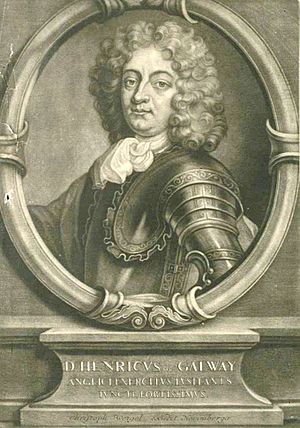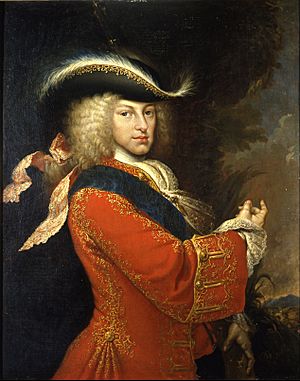Battle of La Gudiña facts for kids
Quick facts for kids Battle of La Gudiña |
|||||||
|---|---|---|---|---|---|---|---|
| Part of the War of the Spanish Succession | |||||||
|
|||||||
| Belligerents | |||||||
| Commanders and leaders | |||||||
| Strength | |||||||
| 18,000 infantry 5,000 cavalry |
16,000 infantry and cavalry | ||||||
| Casualties and losses | |||||||
| 4,000 dead, wounded or captured 17 cannons taken |
400 dead or wounded | ||||||
The Battle of La Gudiña was a major fight during the War of the Spanish Succession. It happened on May 7, 1709, near the towns of Arronches and Campo Maior. This battle was between the Spanish army, led by the Marquis de Bay, and a combined army of Portuguese and British soldiers, led by the Earl of Galway and the Marquis of Fronteira.
The battle ended in a big win for the Spanish. The Anglo-Portuguese army lost a lot of soldiers, with about 4,000 to 5,000 killed, wounded, or captured. The Spanish army, however, had only about 400 soldiers killed or wounded.
Before the battle, the Anglo-Portuguese army marched from Elvas and crossed the Caya River. They soon met the Spanish forces on the plain of La Gudiña. During the fight, the Portuguese cavalry (soldiers on horseback) quickly ran away. This left two groups of British foot soldiers (infantry) unprotected. They were surrounded and had to give up their weapons. Lord Galway, whose horse was shot, barely escaped being captured. The rest of the Anglo-Portuguese army managed to retreat back to Elvas. This victory stopped the allied army from invading Spain from Portugal for a while.
Contents
Why the Battle Happened
After a big loss at the Battle of Almansa, the British were in a tough spot. They had lost most of their power in southeastern Spain. So, Lord Galway asked London for more soldiers. Britain sent 25,000 men. About 8,000 British troops went to Portugal to join Lord Galway. The rest went to Catalonia in Spain.
Planning the Attack
In Portugal, Lord Galway met with the Marquis of Fronteira. They planned a joint attack against Spain and hoped to march towards Madrid, the capital. To do this, they first needed to capture Badajoz. This was a strong Spanish city near the Portuguese border. Lord Galway had tried to capture Badajoz twice before but failed.
This time, he decided not to risk attacking Badajoz directly. He knew that France had moved some troops away because their king, Louis XIV, was losing battles in Flanders. So, Lord Galway's Anglo-Portuguese army, with about 20,000 Portuguese and 8,000 British soldiers, crossed the border near the fortress of Campo Mayor.
Meeting the Enemy
As their huge supply wagons crossed the Caya River, the Anglo-Portuguese army met the first groups of Spanish cavalry. This happened in the fields of Gudiña. The allied army had about 49 groups of infantry and cavalry. The Spanish had about 40 groups. Some reports said the allied army had around 17,000 foot soldiers and 5,000 cavalry. They were thought to be much stronger than the Spanish. Both sides had about 20 cannons.
The Battle Begins
The allied army built nine bridges to cross the Caya River and get ready for battle. In the middle of their army were the troops of the Marquis of Fronteira. However, his soldiers could not see the Spanish infantry, only their cavalry. On the left side of the allied army, the first line was led by the Count of San Juan. The second line was commanded by the Earl of Galway, with three British groups of soldiers. The allies spread out this part of their army. They wanted to use their larger numbers to get around the Spanish army's side.
Spanish Cavalry Attack
The Marquis de Bay led the Spanish cavalry on their right side. He made several small attacks to draw out the Anglo-Portuguese forces. Then, he sent his Spanish cavalry to attack the Portuguese soldiers in the first line. The Spanish cavalry was very well trained and experienced. They quickly made the Portuguese soldiers run away. The Count of San Juan tried hard to get his troops back in order, but he failed and was captured. The Spanish cavalry also captured a group of allied cannons.
Lord Galway's Retreat

Lord Galway then led an attack with three groups of soldiers to try and get the cannons back. But the Spanish dragoons (soldiers who could fight on horseback or on foot) got off their horses and fought the British. The British were forced to retreat. Since the Spanish cavalry was winning the battle, the British tried to retreat into a building. At that moment, Lord Galway quickly got on a horse and escaped. Lord Barrymore and General Pearse were captured. Almost every soldier from the three British groups was either killed or captured. The Spanish cavalry chased the Anglo-Portuguese soldiers, killing 1,500 and capturing 1,000 more.
The first and second lines of the Anglo-Portuguese army on the left side ran away. The British Colonel Ally, who was in charge of the center of the army (which had no cavalry), also ran away. He fled even before the Spanish infantry reached the battlefield. He left behind all the flags, tents, baggage, and guns. He crossed back over the Caya River without destroying the bridges behind them.
What Happened After the Battle

The Portuguese and British suffered a big defeat. They lost about 1,700 men killed or wounded. Around 2,300 soldiers were taken prisoner. They also lost 17 cannons and 15 flags. All their tents and baggage were left behind. The Spanish, on the other hand, lost only about 400 men and 100 horses.
Of the 2,300 prisoners, most were British soldiers, about 1,500 of them. The other 800 were Portuguese. Some of the highest-ranking British officers captured were Major-General James Barry, 4th Earl of Barrymore and Brigadier-General Thomas Pearce. Lord Galway, who had also been unlucky in a previous battle, had his horse shot from under him but managed to escape.
The allies were very disappointed. Their plan to capture Badajoz with their larger army failed. To make things worse, the Marquis de Bay made the Portuguese territory pay for his army's supplies. This showed how badly the British and Portuguese had performed. One writer from London at the time said that the excuses from Portugal were as bad as their fighting. This victory was very good for Philip V of Spain.
See also
 In Spanish: Batalla de La Gudiña para niños
In Spanish: Batalla de La Gudiña para niños

